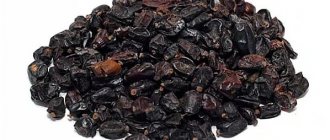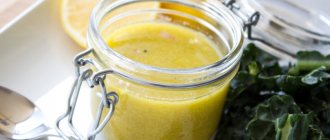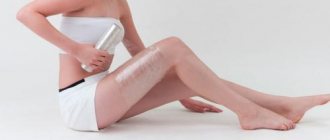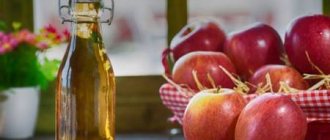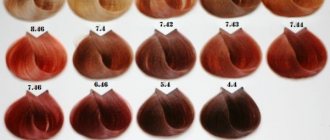Can wine vinegar be replaced with apple cider vinegar?
Various marinades are prepared using wine vinegar, both for meat and for salad dressings and preservation. The range of applications for this product is much wider, because it can be used to treat cuts, eliminate the consequences of bruises, whiten skin and disinfect dishes. Also, this substance can be part of homemade cosmetics.
If this product runs out at the wrong time, but is needed for a salad or other dish, then it can be replaced with any vinegar that was created from natural ingredients. Apple is most suitable for these purposes, but here you need to consider the following.
In grape vinegar product, the acid content is 9%, and in all others it varies between 3-9%. If you find a treasured bottle of apple cider vinegar in your kitchen, pay attention to the label. If the product is of natural origin, then the acid concentration in its composition will be 3-5%, but if it was created artificially, then the acid content will be 9%. That is, replacing with a synthetic product implies a 1:1 ratio. And if the concentration is weak, for example, 6%, then increase the dose of the substitute by 1/3.
Use in cosmetology
Red and white wine vinegar can not only make a dish better, but also significantly affect the condition of your skin and hair.
- If you want to remove unpleasant shine, improve the functioning of the sweat glands, cleanse the skin of dirt and eliminate hated rashes, then it is recommended to treat the skin at least once every two days with the product in question.
- You can also do wine peeling, because vinegar contains acids. To do this, warm it up well and soak gauze with it. Slits are made in it for the eyes, nose and lips, after which it is placed on the face for 10 minutes. Then the product is removed, and after an hour the skin is rinsed, wiped with a hard cloth and toned with an ice cube.
- And if you mix wine vinegar and water, you can apply body wraps that get rid of cellulite.
- As for hair, wine vinegar is a godsend. It has a positive effect on hair that is often colored, removes oily shine, strengthens the structure, stimulates growth, and fights dandruff and fungus.
What can you substitute for white or red wine vinegar?
Acetic acid is a component that is part of any vinegar product, therefore, white and red wine are interchangeable products, and even a great gourmet cannot distinguish them from each other in a salad. If it is important for the cook to introduce an ingredient of a specific color into the composition of the dish (although they do not differ much in taste and properties), then he can replace it with ordinary grape juice, the amount of which should be 3 times larger.
Sometimes these components are replaced with grape juice diluted with white wine in a 1:1 ratio. Also, balsamic, apple, sherry, rice or any other vinegar of natural origin can act as a substitute.
How to make homemade natural wine vinegar from sour wine at home?
If you want to make natural wine vinegar at home from a fermented product (juice, wine, wort).
You will need:
- Wine
(fermented) – more than a liter (approximately 1.5). - Pure water
(distilled or cooled boiled) - 4.5-5 liters. - Sugar –
400 g (can be replaced with the same amount of natural honey).
Blank:
- Pour water into a clean glass container
- Dissolve sugar or honey in water
- Pour fermented wine into water
- Leave the fermentation container in a warm room
- Fermentation time – 2 months
- After this, strain the liquid through a thick layer of gauze.
How to replace wine vinegar with regular table vinegar?
Culinary experts claim that table vinegar is the worst substitute for wine vinegar. But when the housewife finds herself in a desperate situation and there are no other alternatives in the form of citric acid, dime and dry wine, then she will have to use it. The most inconvenient replacement option is vinegar essence, the concentration of which is 70-80%. To obtain the required product from the essence, it is necessary to take into account that 1 tsp. essences = 8 tsp. table vinegar, concentration 9%. Thus, to obtain a three percent solution you need 1 tsp. essence add 22 tsp water.
If you need six percent, then add 11 tsp of water, and for nine percent, 7 tsp. water. The resulting solution, replacing wine vinegar, is added in the same amount, although the concentration is decisive here, and it can easily be determined independently.
Recipe for butter marinated without vinegar with onions
Pickling with onions produces a delicate taste.
Ingredients:
- Butter - 1.5 kg.
- Black peppercorns – 5 pcs.
- Onion – 300 gr.
- Dry mustard – ½ tsp.
- Water – 500 ml.
- Lemon – 0.5 tsp.
- Salt – 50 gr.
- Sugar – 60 gr.
- Laurel – 3 pcs.
Instructions:
- Boil the mushrooms for 30 minutes. Pour into a colander.
- Place in a container.
Prepare the marinade separately:
- Peel the onion and cut into half rings.
- Place the onion in water with salt, pepper, and spices.
- Boil for 5 minutes.
- Distribute the mixture while hot into jars.
- Leave to sterilize for 20 minutes. into the oven.
- Take it out, roll it up, turn it over.
It is better to marinate in small jars with screw lids.
For a change, discover a recipe for how to make cheese from milk and kefir. This cheese contains a lot of casein, which is appreciated by athletes and not only.
Can wine vinegar be replaced with balsamic vinegar?
You can, the only problem is that the cost of a real balsamic vinegar product is 100 euros for a 30 ml bottle, therefore, it is not the cheapest analogue. This price is explained by the complexity of the technological process, because the product must reach its condition in oak barrels for at least 12 years.
Attention! Using balsamic vinegar instead of wine vinegar is not economically feasible, especially since it is too strong, and if the proportions are not respected, it can ruin the dish.
Replacing wine vinegar
In salad
- Lemon acid. This is an alternative for all occasions. If you need to replace a 9% wine vinegar product, then 1 tsp. citric acid is diluted with 14 tbsp. l water; for a six percent water option you will need 22 tbsp. l.
- Grape juice. Its quantity increases 3 times, and to enhance the taste, seasonings must be added to the grape juice.
- Dry wine. It will be much better if you dilute it with grape juice in a 1:1 ratio.
- Any vinegar of natural origin. The product obtained from vinegar essence according to the above recipe can only be used in a desperate situation.
- Freshly squeezed lemon juice, which can be diluted with either grape juice or white or red wine.
How to use wine vinegar for acne: recipes
In addition to internal use, vinegar has also found successful external use. For example, vinegar can treat skin inflammation, as this liquid has a powerful bactericidal, disinfectant and antiseptic effect. That is why regularly cleansing the skin with vinegar will relieve inflammation and fight blackheads.
It is enough to moisten a cotton pad with wine vinegar and wipe the skin of a cleansed face to achieve a positive effect:
Wine vinegar can be beneficial when used correctly. It will nourish the hair with a lot of useful microelements, amino acids and enzymes (which are useful for hair growth). Using vinegar too often will dry out your hair, and not using enough vinegar will cause breakage and hair loss.
IMPORTANT: In order to achieve the effect, it is enough to replace the chemical hair rinse with rinses with vinegar.
Wine vinegar for strengthening hair:
- Brew a concentrated sage decoction
- Add 2-3 tbsp to the cooled broth. wine vinegar
- Apply the decoction to clean, damp hair
- No need to rinse
- Course of treatment: 2 times a week for 2 months
Wine vinegar for hair shine:
- Brew 2-3 tbsp. dried chamomile flowers in a liter of water
- Add 2-3 tbsp to the cooled broth. wine vinegar (light)
- Use the decoction to rinse your hair after shampooing.
- The product should not be washed off
Wine vinegar for oily hair:
- Dilute vinegar with water 1:1
- The comb should be soaked in this liquid.
- Use a comb or hair brush to comb your hair
- This procedure should be done before going to bed at night.
- In the morning, wash your hair with shampoo
Wine vinegar mask for oily hair:
- One apple should be chopped in a blender (pulp only).
- Add 1-2 tbsp to applesauce. wine vinegar
- Apply the mask to the hair roots and leave for 20-30 minutes.
- Rinse off the mask with water, and then wash your hair thoroughly with shampoo.
Wine vinegar for dandruff:
- Brew 2-3 tablespoons of boiling water (1 liter). dry burdock
- Dilute the cooled broth with 1-2 tbsp. wine vinegar
- Soak gauze or cloth in the solution and leave it on your head as a compress.
- Keep the compress for 20-30 minutes
- Rinse the product off your head with water and shampoo.
Wine vinegar for hair loss, mask:
- Dissolve vinegar in liquid natural honey 1:1
- Add a little warm water to make the mask liquid
- Apply the mask over the entire length of your hair
- Leave the product for 20-30 minutes and rinse thoroughly with shampoo
Recipes for using wine vinegar for hair
Wine vinegar in cooking
The presented product is actively used by chefs around the world. Its taste has long become familiar to many. In most cases, the entire gamut of taste and aroma of wine vinegar is used to prepare a wide variety of marinades suitable for meat and fish dishes.
Don’t forget that adding a dressing based on this product to a salad will make even well-known vegetables much tastier.
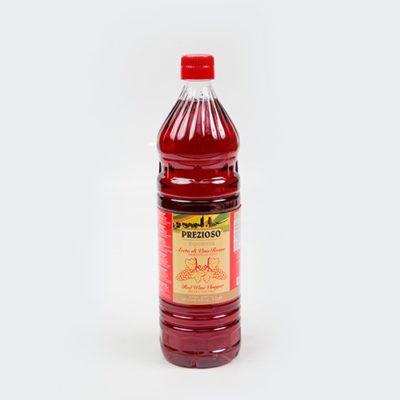
How to marinate boletus without vinegar and citric acid
Without adding acid-containing components, you can ferment mushrooms like cabbage.
Ingredients:
- 2.5 kg. oily.
- 125 g salt.
- 3 l/leaf.
- 10 peas of allspice.
Instructions:
- Mushrooms for pickling do not need to be peeled.
- Rinse, sprinkle with salt and spices.
- Place in an enamel container.
- Put it under pressure.
- After 21 days, transfer to glass containers under nylon lids.
- Store in a cool place

Butter with fresh onions and butter is a wonderful appetizer for the table.
What can you replace wine vinegar with?
Wine vinegar is used in the preparation of marinades, dressings, and in baking bread. It helps make the dough fluffy, and saturates meat snacks with original flavors and adds a light, pleasant sourness.
If you don’t have a product on hand, you definitely need to know what you can replace it with.
- Vinegar of another type - the use of apple cider vinegar and table vinegar is completely justified. You just need to follow the correct proportions, taking into account the concentration of each option for such a replacement.
- Wine. A small amount of wine will not spoil the sauce for meat or fish, just add a little wine, otherwise notes of alcohol will ruin the dish.
- Lime juice, lemon. Each of these options is good in fresh salads or light dressings for fish and meat. You should not add too much fresh juice so that it does not interrupt the main taste of the product.
- Using balsamic vinegar instead of wine vinegar is expensive. It is also important to take into account that the strong aroma and taste of balsamic cannot enhance all dishes; some become significantly worse.
- Grape juice can be substituted for red wine vinegar if rich color is essential to the cook. Keep in mind that the juice is not as concentrated as vinegar; you will need three times more of it.
Wine vinegar is in demand in cooking, but is far from the most popular product. If you use it skillfully, you can fill familiar dishes with new notes. If you don’t have the product you need at hand, don’t worry, because worthy replacement options will save the taste of your culinary masterpieces.
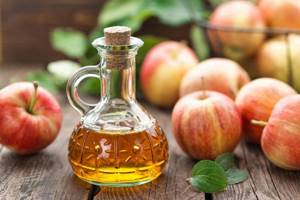
Vinegar is a seasoning known since ancient times. It is obtained from raw materials containing alcohol during the fermentation process with the participation of acetic acid bacteria. Contains various acids: acetic acid, as well as citric, malic, tartaric and many others.
Wine vinegar and balsamic, apple, grape, table vinegar: what is the difference?
There are several common types of vinegar and each differs in its composition, and, consequently, in its effect on the body. Any vinegar is used not only in cooking, but also in folk medicine and cosmetology.
Types of vinegar and their features:
- Grape vinegar -
obtained by fermenting either wine or grape juice. Due to the high content of essential oil in vinegar, the liquid has a pleasant aroma. Traditionally, red vinegar is made from Bordeaux wines and has a bright and rich taste. White wine vinegar has a milder color and flavor. This vinegar is perfect for marinating all types of meat and preparing delicious dressings and sauces. - Apple cider vinegar
is produced by fermenting apple cider and has a milder taste and aroma than wine vinegar. This vinegar is considered the most useful, both for consumption and for making beauty care products. This vinegar contains about 20 essential vitamins and minerals, as well as amino acids. Vinegar has found its use in cooking due to its pleasant “bouquet” of aromas and only slightly sour taste. - Table vinegar -
this liquid is often called “alcohol vinegar.” It is made from ethyl alcohol. Often used in cooking: marinating meat, canning, dressing salads, making mayonnaise. The difference between table vinegar and others is that it has a pronounced unpleasant odor. - Balsamic vinegar is
the most aromatic and rich-tasting vinegar. This vinegar is obtained by fermenting sweet varieties of white grapes (Trebbiano variety). Balsamic vinegar is added to many dishes: meat, vegetables, salads, soups, even desserts. Balsamic vinegar is prepared by infusing in oak barrels for several years (up to 12). - Malt vinegar
is produced by fermenting beer, or rather beer wort. Vinegar has a pleasant aroma and light taste; the liquid has a honey tint. Vinegar is good for marinating fish and meat, preparing dressings and sauces, and canning. - Rice vinegar is
very popular in Asia. The liquid has a pleasant light aroma and taste. There are several varieties of rice vinegar: black, red and white. It is added to various dishes to enhance their taste and aroma. - Synthetic vinegar -
obtained by infusing sawdust. This is a liquid concentrated in acetic acid. In most countries, this vinegar is prohibited for consumption due to the high likelihood of harm to humans. - Coconut vinegar is
a rare product made by fermenting coconut milk directly inside the nut. The liquid has a pronounced, slightly pungent aroma, a huge supply of trace elements and amino acids. Used for marinating meat and preparing delicious dressings. - Cane vinegar is
a product obtained by fermenting dissolved cane sugar. This vinegar has a sharp, slightly unusual smell, but a rich and pleasant taste. This vinegar can be used to dress salads and marinate meat. - Sherry vinegar is
a type of wine vinegar. Produced from the palomino grape variety.
Synthetic vinegar Apple cider vinegar
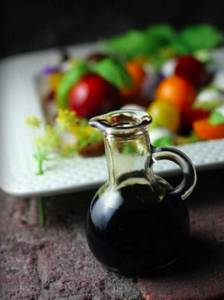
Sherry vinegar Wine vinegar Table vinegar Balsamic vinegar Malt vinegar Coconut vinegar Rice vinegar Cane vinegar
How to replace vinegar
Vinegar is actively used in canning, pickling, and is added to salads and soups. It adds piquancy and sets off the taste of the other ingredients. Sometimes, for various reasons, it is necessary to replace vinegar with another product.
Replacing vinegar in borscht
Lemon juice or citric acid (crystals) will do an excellent job for the same purposes for which vinegar is used in borscht - it will preserve the bright color of the beets and broth, and add the necessary sourness. This is the simplest and most affordable replacement option.
Add a little at a time so you don't overdo it! A tiny pinch of acid crystals or a dessert spoon of lemon juice is enough. Add onion, carrot and beet dressings during preparation.

Photo source: rumelo.ru
In baking
In yeast-free dough, soda slaked with vinegar is used to improve the texture of the finished product - the released carbon dioxide makes the baked goods more airy and porous. If vinegar is not on hand, you can replace it with berry, lemon, apple or grape juice, fermented milk products: yogurt, whey, sour cream - just add a teaspoon of any of the listed ingredients. You can also extinguish sodium bicarbonate with dry white wine.
How to pickle boletus without vinegar
Marinating without vinegar differs in the composition of the marinade. Replace vinegar with lemon. For piquancy, add honey, garlic, and onion.
Preparing butter for salting or pickling without vinegar
To pickle butter, prepare it properly.
Instructions:
- Do not soak before cleaning.
- Remove the top skin from the mushrooms.
- Divide large ones into parts.
- Rinse under running water.
- Soak for 1.5 hours.
- Wash again.
- If you don’t want to bother with the skin, use a hard sponge to clean off the dirt and leaves.
- In this case, cook in three stages, changing the water.
Your hands will turn black when cleaning, wear gloves or wipe with lemon juice when finished.
Video advice on how to clean boletus, see the following link:
Preparing jars
It’s better to roll it up in small jars. Prepare the container for marinating.
Instructions:
- Wash with a sponge and soda.
- Rinse under warm water.
- Pour 50 gr. liquid into each jar.
- Place in the microwave at 750 kW for 2-3 minutes.
- If you don't have a microwave, sterilize using steam.
- Place a colander over a saucepan of boiling water.
- Turn the jars upside down.
- Sterilize for 7 minutes.
Author's note
Agapov Vladislav
When removing hot dishes, use kitchen gloves to avoid getting burned.




